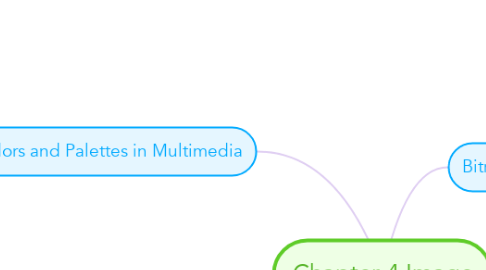
1. Bitmap
1.1. >simple matrix of the tiny dots that form an image
1.2. >made up of individual dots or picture elements known as pixels or pels
1.3. >Capture a bitmap using a camera
1.4. >paint or drawing program
1.5. >Download from an image from website
1.6. >eg=Adobe’s Photoshop and Illustrator
2. Vector
2.1. >Computer-aided design (CAD) programs needed by architects and engineers
2.2. >3-D animation programs
2.3. >a line that is described by the location of its two endpoints
2.4. >Vector drawing makes use of Cartesian coordinates
2.5. >less memory space and have a smaller file size
2.6. >easily scalable without loss of resolution or image quality
2.7. >cannot be used for photorealistic images.
3. Colors and Palettes in Multimedia
3.1. Additive color
3.1.1. a color is created by combining colored light sources in three primary colors - red, green, and blue (RGB).
3.1.2. TV and computer monitors use this method
3.2. Subtractive color
3.2.1. color is created by combining colored media such as paints or ink
3.2.2. the process used to create color in printing.
3.2.3. The printed page consists of tiny halftone dots of three primary colors: cyan, magenta, and yellow (CMY).
3.3. Color palettes
3.3.1. mathematical tables that define the color of pixels displayed on the screen
3.4. Dithering
3.4.1. whereby the color value of each pixel is changed to the closest matching color value in the target palette
4. Image File Types Used in Multimedia
4.1. Macintosh formats
4.1.1. the most commonly used format is PICT
4.1.2. complicated and versatile format developed by Apple
4.1.3. Almost every image application on the Macintosh can import or export PICT files
4.1.4. In a PICT file, both vector-drawn objects and bitmaps can reside side by side
4.2. Windows formats
4.2.1. commonly used image file format on Windows is DIB, also known as BMP
4.3. Cross-platform formats
4.3.1. JPEG, GIF, and PNG – Most commonly used format on the Web
4.3.2. Adobe Portable Document Format (PDF) – Manages multimedia content
4.3.3. PSD, AI, CDR, DXF – Proprietary formats used by applications

